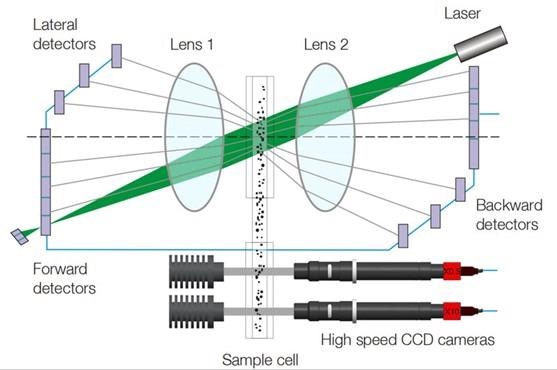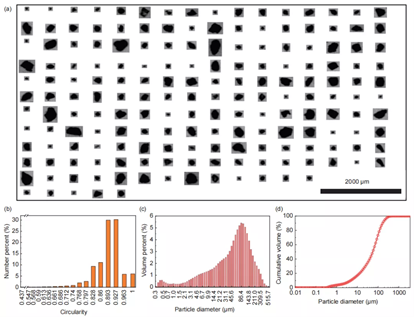On December 17, 2020, Chang'E-5 landed safely with lunar samples. The mission was successfully completed, bringing back a total of 1731 grams of lunar rock and soil samples.

Figure 1. On-site camera images of the sampling site of the Chang’E-5 mission before and after digging. Image credit: Bettersize Instruments
On July 12, 2021, the Qian Xuesen Laboratory of the Chinese Academy of Space Technology obtained the first batch of lunar samples issued by the National Space Administration and conducted research on the size, morphology, and composition of the samples. On October 19, 2021, the Chinese Academy of Sciences released the research results of the Chang'E-5 lunar scientific research samples, the research was led independently by Chinese scientists. The Bettersizer S3 Plus laser particle size and particle shape analyzer was used as the main analysis equipment and successfully completed the task.

Figure 2. The release conference of the first batch of lunar scientific research samples. Image credit: Bettersize Instruments

Figure 3. Bettersizer S3 Plus laser particle size and shape analyzer. Image credit: Bettersize Instruments
The study of the physical and chemical properties of the lunar soil has tremendous significance for the exploration of the moon and the utilization of lunar resources. Detecting the grain size and distribution of lunar soil is of great help to humans in understanding the moon. Whether there is an agglomeration of particles reflects the existence of water resources on the moon, and the distribution results can also be used to infer the natural phenomena of the moon, including solar wind injection, meteorological or micrometeorological impacts, and weathering. By measuring the grain shape and size information of the lunar soil in different locations, the causes of the different topography of the moon can be studied. Qian Xuesen's laboratory used Bettersizer S3 Plus to measure the particle shape and particle size distribution of the sample. Bettersizer S3 Plus is a combination of laser diffraction and dynamic image analysis. Both technologies complement each other to expand the scope of analysis, realize accurate measurement of the particle size of millimeter, micrometer and even nanometer samples, and also allow researchers to know the shape of the particles well.
“Particle size and shape distributions for CE-5 LR were measured via Bettersizer S3 Plus laser diffractometer coupled with an image analyzer. The laser diffractometer with a light wavelength of 532 nm could analyze particle sizes between 0.01 and 3500 µm. While particle images were recorded and analyzed in the size range of 2-3500 µm.” (Science China) This paper will be published in March 2022

Figure 4. Laser diffraction + dynamic imaging two-in-one system (Bettersize patented technology). Image credit: Bettersize Instruments
According to experiments, lunar soil has a wide range of particle size distribution, with small particles reaching 0.31 μm and large particles reaching 515.70 μm. According to the cumulative distribution diagram of particle size, typical particle size values commonly used in soil analysis: D10, D30, D50, and D60 are 4.75±0.39 μm, 24.34±0.91 μm, 55.24±0.96 μm and 71.87±0.89μm. The wide size distribution of lunar soil samples can be observed from the frequency distribution diagram of particle size, and the particle size distribution is a continuous shape. The image taken by the high-speed CCD camera equipped in Bettersizer S3 Plus shows that the grains of the lunar soil has a uniform shape, with an average circularity of 0.875, and only about 10% of the particles have a circularity smaller than this value.
This result is different from the previous measurement results of the lunar soil samples brought back by the Apollo program. The reason of the difference is in the classification method-the Apollo lunar soil samples used a method of sieving based on quality. From 2008 to 2010, the laser method was used to analyze the Apollo lunar soil samples again, and the result of the middle diameter was 66.47-30.05 μm, which is closer to the result of Bettersizer S3 Plus. Bettersizer S3 Plus has a stronger dispersing effect on samples, avoids the possible agglomeration phenomenon of the screening method, and will not cause damage and loss to precious samples, and the results are more intuitive and reliable.

Figure 5. Particle shape and size distributions of the lunar sample CE5C0400. (a) Representative images of individual particles via laser diffraction; (b) circularity distribution with sizes ranging from 15.0 to 438.2 µm; (c) volume percent distribution; (d) cumulative volume profile via laser diffraction. Image credit: Bettersize Instruments
Table 1: Basic physical properties of lunar sample CE5C0400 returned by the Chang’E-5 mission. Credit: Bettersize Instruments

Bettersizer S3 Plus has made many other outstanding contributions to lunar soil research, and its laser and image combined technology provides assistance for laboratory research. Qian Xuesen’s laboratory used simulated lunar soil to verify the accuracy of the instrument. The experimental results of particle shape and particle size were accurate and reliable, and the analytical results provided by the instrument are of great reference. Therefore, Qian Xuesen’s laboratory continued to choose Bettersize instruments to study the size and morphology of the real precious lunar soil samples.
On the other side of planet earth, the Institute of Environmental and Earth Sciences at the University of Munich in Germany also used Bettersize instruments for lunar soil analysis and research. The results of Bettersizer S3 Plus also received great reviews from the laboratory.


Figure 6. The Bettersizer S3 Plus currently in service at the Institute of Environment and Earth at the University of Munich, Germany. Image credit: Bettersize Instruments
Many international cutting-edge scientific research projects used the Bettersizer S3 Plus laser particle size and shape analyzer for project research, and to analyze rare samples. Bettersize Instruments will continue to improve its technology in the future and help national and international aerospace industry to a higher level with superior product quality.
For more information about Chang'E-5 mission, please visit: https://bit.ly/3oF00YE
For more information about Bettersizer S3 Plus, please visit: https://bit.ly/3rQiHeb